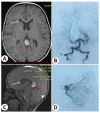Long-Term Outcomes of Endovascular Embolization in a Vein of Galen Aneurysmal Malformation: A Single-Center Experience
- PMID: 37627963
- PMCID: PMC10453383
- DOI: 10.3390/diagnostics13162704
Long-Term Outcomes of Endovascular Embolization in a Vein of Galen Aneurysmal Malformation: A Single-Center Experience
Abstract
Background: A vein of Galen aneurysmal malformation (VGAM) is a rare congenital cerebral vascular condition with a high mortality rate if left untreated. This study describes the long-term outcomes of patients with VGAM, who were treated with endovascular embolization.
Methods: This retrospective analysis focused on VGAM patients who underwent one or more endovascular embolization sessions between January 2008 and December 2022. The study included newborns and children under 18 years. Data encompassed clinical and demographic characteristics, types of endovascular embolization, treatment complications, mortality rates, and long-term outcomes.
Results: Out of 22 VGAM cases, the majority were boys (86.36%), and the average age of the participants was 38 months, ranging from 25 days to 17 years. Endovascular embolization using liquid embolizing agents was the most common intervention (50%), and around 73% of patients underwent multiple sessions. Some patients underwent ventriculoperitoneal shunting (VPS) due to persistent hydrocephalus. In long-term outcomes, four patients (18.2%) showed developmental delays, and 16 patients (72.7%) had a positive outcome.
Conclusions: Combining endovascular therapy with a comprehensive management strategy significantly reduces mortality rates and improves the possibility of normal neurological development in patients.
Keywords: AV malformation of the vein of Galen; Bicêtre score; endovascular embolization; hydrocephalus; neonates; the vein of Galen aneurysmal malformation.
Conflict of interest statement
The authors declare no conflict of interest.
Figures




Similar articles
-
Cognitive and functional status after vein of Galen aneurysmal malformation endovascular occlusion.World J Radiol. 2012 Mar 28;4(3):83-9. doi: 10.4329/wjr.v4.i3.83. World J Radiol. 2012. PMID: 22468188 Free PMC article.
-
Susceptibility weighted imaging in infants with staged embolization of vein of Galen aneurysmal malformations.J Neuroradiol. 2019 May;46(3):214-221. doi: 10.1016/j.neurad.2018.09.009. Epub 2018 Nov 10. J Neuroradiol. 2019. PMID: 30423378
-
Endovascular Management of Vein of Galen Aneurysmal Malformations: A Retrospective Analysis over a 15-Year Period.J Vasc Interv Neurol. 2019 May;10(3):23-29. J Vasc Interv Neurol. 2019. PMID: 31308867 Free PMC article.
-
[Vein of Galen aneurysmal malformation].Radiologie (Heidelb). 2022 Aug;62(8):671-674. doi: 10.1007/s00117-022-01029-z. Epub 2022 Jun 23. Radiologie (Heidelb). 2022. PMID: 35736995 Review. German.
-
ETV as treatment for obstructive hydrocephalus in an aneurysmal malformation of the vein of Galen in infants: case report and review of literature.Childs Nerv Syst. 2023 Jun;39(6):1667-1672. doi: 10.1007/s00381-023-05877-5. Epub 2023 Feb 17. Childs Nerv Syst. 2023. PMID: 36797497 Review.
Cited by
-
Effective endovascular treatment of veins of Galen malformation in a child: A case study.Radiol Case Rep. 2025 Jul 24;20(10):5131-5136. doi: 10.1016/j.radcr.2025.06.021. eCollection 2025 Oct. Radiol Case Rep. 2025. PMID: 40746741 Free PMC article.
-
Vein of Galen Aneurysmal Malformations: Updates on Technical Aspects and Functional Outcomes Post-Endovascular Treatment-A Systematic Review and Meta-Analysis.Medicina (Kaunas). 2024 Nov 26;60(12):1948. doi: 10.3390/medicina60121948. Medicina (Kaunas). 2024. PMID: 39768831 Free PMC article.
References
-
- Gaillard J. The Genetics of Vein of Galen Malformation and Assessment of Candidate Genes in Xenopus Tropicalis. Yale Med. Thesis Digit. Libr. 2019;1:11–13.
Grants and funding
LinkOut - more resources
Full Text Sources

